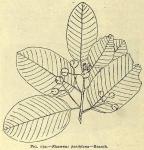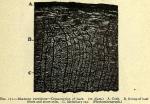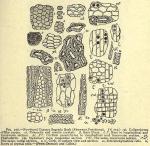
 The dried bark of the trunk and branches of Rham'nus purshian'a De Candolle.
The dried bark of the trunk and branches of Rham'nus purshian'a De Candolle.
BOTANICAL CHARACTERISTICS.—Plants of this species of Rhamnus attain a height of 10 to 20 feet. The leaves are ovoid, 3 to 5 in. in length, and about ½ in. in their greatest width, serrate except at base (?— MM). Flowers are small and white, appearing after the leaves have matured. The fruit is a plain, round, black berry about ¼ in. in diameter, and contains three seeds. This species differs from other species of Rhamnus in that it is a larger tree and bears a larger fruit.
SOURCE.—Several allied species growing in the cascara district in California seem to contribute the cascara sagrada bark of the market. The official species grows abundantly in Northern California, Oregon, and Washington. "If the bark comes and is actually collected from Northern California, it is presumptive evidence that it is genuine. The probabilities of adulteration increase with its southward sources, and if collected in, or south of Central California, it is to be looked upon with greatest suspicion" (Rusby).
DESCRIPTION OF DRUG.—Curved pieces or quills 1 to 4 mm. to (1/25 to ⅙ in.) thick, and about 100 mm. (4 in.) long. The outer surface is reddish brown, frequently more or less covered with grayish or whitish lichens, the young bark having numerous rather broad, pale-colored warts; sometimes mottled or figured; inner surface smooth and finely striate, yellowish, turning brown or nearly black on exposure; fracture short, yellowish, of the inner layer somewhat fibrous and thick. A cross-section shows numerous thin, almost straight, broadening medullary rays, which run on an average about three-fourths of the distance across the bark. Medullary rays in groups converging at their outer ends (distinction from Rhamnus Californica); stone cells present (distinction from Rhamnus frangula). If to a small quantity of the powdered barks an alkaline solution be added, the color developed in the Rhamnus Californica is a deep red, while that of R. Purshiana is orange. Odor distinct; taste bitter and slightly acrid.
 Powder.—Characteristic elements of: See Part iv, Chap. I, B.
Powder.—Characteristic elements of: See Part iv, Chap. I, B.
CONSTITUENTS.—Emodin and frangulic acid; frangulin and purshianin—the two latter being glucosides, yielding, on hydrolysis, emodin and sugar. The principle, emodin, is found in many purgative drugs. Its composition, and its relation to several carbon compounds are shown in the following:
| C14H10 | C14HSO2 | C14H6(OH)2O2 | C14H4CH3(OH)3O2 |
| Anthracene | Anthraquinone | Chrysophanic Acid | Emodin |
Emodin is, therefore, said to be a trioxy-methyl-anthraquinone. It is contained in rhubarb, senna, aloes, etc. See emodin test under Rhubarb (120). The resins are turned a vivid purple-red by caustic potash. The fresh bark is active as a purgative, causing much griping. By keeping and properly curing, however, this griping principle is destroyed, and the bark becomes more accurate in action and less likely to cause this discomfort. Ash, usually about 8 per cent.
Purshianin is a glucoside reported by Dohme and Englehardt. Obtained by first removing oil, etc., from the drug by means of chloroform, then extracting the residue with alcohol, etc. It crystallizes from acetone and ethylic acetate in dark brown-red needles, melting at 237°. On heating with alcoholic hydrochloric acid it yields sugar and emodin.
ACTION AND USES.—A valuable laxative in chronic constipation. Dose: 30 to 60 gr. (2 to 4 Gm.).
OFFICIAL PREPARATIONS.
- Extractum Cascara Sagradae, . . . Dose; 4 gr. (0.25 Gm.).
- Fluidextractum Cascara Sagradae, . . . Dose, 15 ♏︎ (1 mil).
- Fluidextractum Cascara Sagradae Aromaticum, . . . Dose, 30 ♏︎ (2 mils).

